1. Polar Bear: The Arctic’s Iconic Predator

Polar bears, the poster children of climate change, are facing a grim future as Arctic sea ice vanishes at an alarming rate of 13% per decade. These majestic hunters are losing their primary hunting grounds, making it increasingly difficult to reach their favorite prey – seals. Scientists predict a two-thirds decline in polar bear populations by 2050, painting a chilling picture of a world where these white giants no longer roam the Arctic. A recent study published in Science revealed that the Western Hudson Bay population has declined by nearly 50% over the past four decades, with the average body mass of adult females dropping by a staggering 39kg (86lbs) and one-year-old cubs by 26kg (47lbs) over a 37-year period.
The root cause of this decline is an extended “energy famine” caused by shrinking sea ice. As the ice-free period grows longer, polar bears are forced to fast for extended periods, depleting their fat reserves. This energy deficit is particularly devastating for mothers and cubs. With shorter hunting periods, mothers produce less milk, jeopardizing cub survival. Cub litter sizes have dropped 11% compared to almost 40 years ago, and mothers are keeping their cubs longer because they aren’t strong enough to live on their own. The researchers’ bio-energetic model, which tracks the energy balance of individual polar bears throughout their lifecycle, provides a near one-to-one match with real-life observations. This grim forecast isn’t limited to Western Hudson Bay – as the Arctic warms at a rate four times faster than the global average, similar declines are expected in other polar bear populations across the Arctic.
2. Ringed Seal: The Ice Hole Houdini

Ringed seals, the polar bear’s favorite snack, are facing their own set of challenges as the Arctic warms. These agile swimmers, known for their ability to create and maintain breathing holes in the ice, are losing their nursery floors as sea ice melts faster than ever. Pups need stable ice to survive their first few weeks of life, but with ice breaking up earlier and forming later, they’re increasingly vulnerable to predators and drowning. A study published in Ecological Applications revealed that changes in snow and ice conditions could lead to dramatic decreases in ringed seal populations. The research showed that in years with poor ice conditions, pup mortality rates can reach up to 100% in some breeding areas.
The challenges for ringed seals extend beyond the immediate threat to pups. As Arctic sea ice declines, the timing of important life events for these seals is being disrupted. The loss of sea ice affects the distribution of their prey, primarily fish and invertebrates, which could lead to nutritional stress for ringed seal populations. Additionally, the changing ice conditions are altering the seals’ molting patterns and migration routes. With sea ice in the Barents Sea around Svalbard now increasing at the staggering rate of 65 ice-free days per decade, ringed seals are facing a rapidly changing environment that they may struggle to adapt to. The fate of ringed seals is inextricably linked to that of polar bears and the entire Arctic ecosystem, making their plight a stark indicator of the far-reaching impacts of climate change in the region.
3. Walrus: The Tusk-Tastic Ice Lounger

Walruses, those massive marine mammals with impressive tusks, are facing significant challenges as Arctic sea ice disappears. These 3,000-pound behemoths rely on sea ice as resting platforms between diving for clams and other bottom-dwelling prey. However, with ice loss occurring at a rate of 13% per decade, walruses are increasingly forced to haul out on land in large numbers. A striking example of this occurred in 2014 when an estimated 35,000 walruses crowded onto a single beach in Alaska, a phenomenon directly linked to the lack of available sea ice. This overcrowding can lead to deadly stampedes, with hundreds of walruses, particularly young ones, at risk of being crushed when the group is startled.
The loss of sea ice is not just changing walrus behavior; it’s also affecting their energy balance and reproductive success. Walruses typically use ice floes as floating platforms to rest between feeding dives and to nurture their young. Without these platforms, they must swim longer distances to reach feeding grounds, burning precious energy reserves. A study by the U.S. Geological Survey found that female walruses and their calves are particularly vulnerable to these changes. The energy cost of swimming long distances between feeding areas and terrestrial haul-outs can lead to reduced body condition and lower reproductive rates. Additionally, the crowded conditions on land increase the risk of disease transmission and make it more difficult for mothers to care for their calves. As the Arctic continues to warm, the future of these tusked marine mammals remains uncertain, with their fate closely tied to the rapidly changing sea ice conditions.
4. Arctic Fox: The Snow-Coated Scavenger
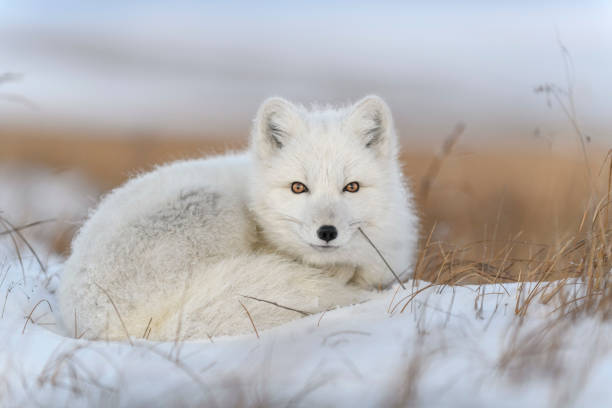
The Arctic fox, a small but resilient predator of the tundra, is facing a double threat from climate change. These agile hunters, known for their brilliant white winter coats, are losing their camouflage advantage as snow-free periods in the Arctic lengthen. A study published in The Journal Biological Conservation found that the duration of snow cover in some Arctic regions has decreased by up to two weeks per decade since the 1970s. This change not only affects the Arctic fox’s hunting success but also exposes them to increased predation risk from larger carnivores like red foxes, which are expanding their range northward as temperatures warm.
Climate change is also altering the Arctic fox’s food web in complex ways. These opportunistic feeders rely heavily on lemming populations, which have traditionally followed cyclical boom-and-bust patterns. However, research published in Nature Climate Change has shown that warming temperatures are disrupting these cycles, leading to more erratic and less predictable food availability for Arctic foxes. In years of low lemming abundance, Arctic foxes depend more on marine resources, scavenging from seal carcasses left by polar bears on sea ice. As sea ice declines, this crucial alternative food source becomes less accessible. The combination of these factors – loss of camouflage, increased competition, and changes in prey availability – is putting significant pressure on Arctic fox populations. In some areas, such as Fennoscandia, Arctic fox numbers have declined by more than 90% over the past century, with climate change identified as a key driver of this alarming trend.
5. Narwhal: The Unicorn of the Deep
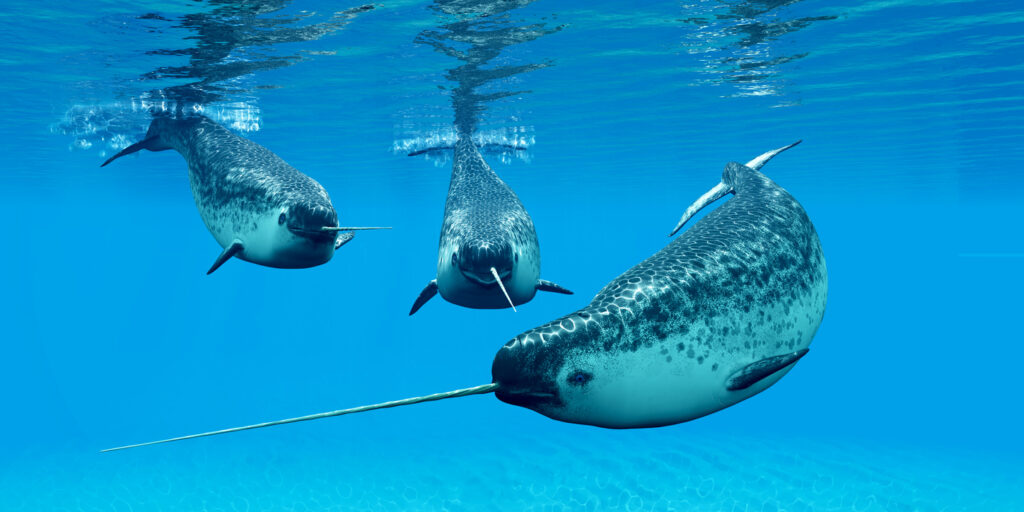
Narwhals, often called the “unicorns of the sea” due to their distinctive spiral tusks, are facing unprecedented challenges in a rapidly warming Arctic. These elusive whales are highly adapted to life in icy waters, using sea ice for protection from predators and as a hunting ground for their preferred prey, Arctic cod and Greenland halibut. However, a study published in the journal Global Change Biology found that the ongoing loss of Arctic sea ice is forcing narwhals to alter their traditional migration routes and feeding patterns. The research, which used satellite tracking data, revealed that narwhals are spending more time in ice-free waters, potentially exposing them to increased predation by orcas and competition from other whale species moving northward.
The impacts of climate change on narwhals extend beyond habitat loss. These deep-diving cetaceans are also vulnerable to the effects of ocean acidification, a direct result of increasing carbon dioxide levels in the atmosphere. A report from the Arctic Monitoring and Assessment Programme (AMAP) highlighted that the Arctic Ocean is acidifying faster than any other ocean basin on Earth. This change in ocean chemistry could have severe consequences for the narwhal’s food web, particularly affecting the abundance and distribution of their prey species. Additionally, the opening of previously ice-covered Arctic waters to increased shipping and oil exploration poses new threats to narwhals in the form of noise pollution and the risk of oil spills. With an estimated global population of only about 80,000 individuals, narwhals are particularly vulnerable to these cumulative stressors. Their specialized adaptations to Arctic life, once an evolutionary advantage, now make them one of the marine species most at risk from the rapid environmental changes occurring in the Far North.
6. Beluga Whale: The Canary of the Sea
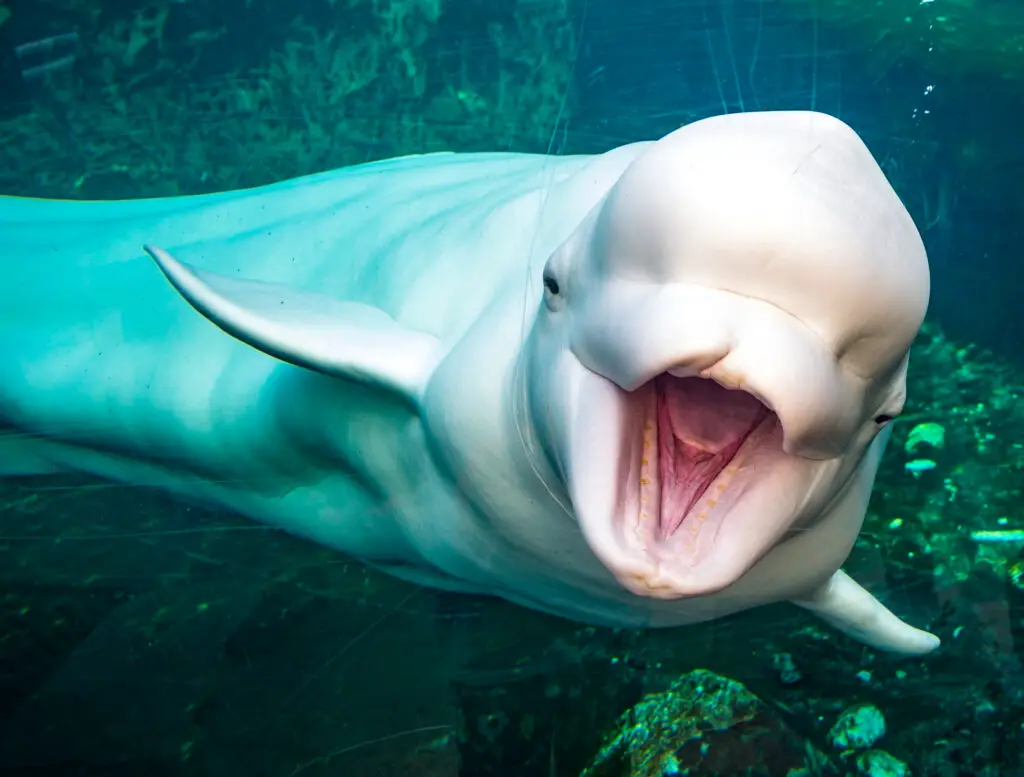
Beluga whales, known as the “canaries of the sea” for their distinctive vocalizations, are facing significant challenges due to climate change. These white whales, weighing up to 3,500 pounds, inhabit Arctic and sub-Arctic waters, relying on sea ice for protection and as hunting grounds. A 2024 study published in Frontiers in Marine Science revealed a negative correlation between sea surface temperature and beluga whale aggregations, suggesting that warming temperatures may impact their distribution patterns. The research predicts that ocean temperatures in Arctic and sub-Arctic regions could rise by up to 3°C by the end of the century, potentially pushing beluga populations towards cooler southern areas. This shift could lead to increased competition with other marine mammal species moving northward, putting further stress on beluga populations.
The changing Arctic environment is also affecting beluga whale migration patterns and food sources. As sea ice retreats, belugas are being forced to dive deeper and for longer periods to find food, as warming waters alter the distribution of their prey species. This increased energy expenditure could lead to nutritional stress and reduced reproductive success. Additionally, the opening of ice-free shipping routes in the Arctic exposes belugas to increased risks of ship strikes and noise pollution, which can disrupt their communication and navigation. A study by the Earth.com news team highlights that if belugas are unable to adapt to these rapid changes, they may face drastic population declines. The research emphasizes the need to understand how beluga whales will adjust their migration patterns, find new habitats, or even change their diet to survive in this changing environment.
7. Bowhead Whale: The Ice-Breaking Giant
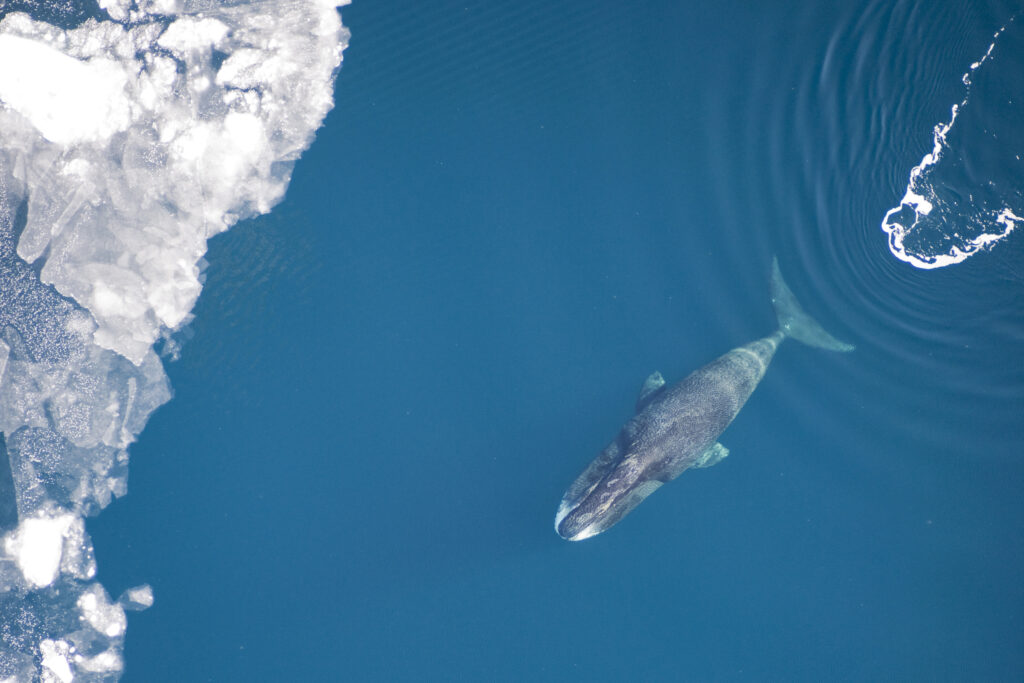
Bowhead whales, Arctic giants reaching lengths of up to 60 feet and weights of 100 tons, are facing new challenges in the rapidly changing Arctic landscape. These long-lived whales, which can survive for over 200 years, have evolved to thrive in icy waters, using their massive skulls to break through sea ice up to 2 feet thick. However, as sea ice retreats, bowheads are encountering unprecedented changes in their habitat. A study by Oregon State University, using 12 years of underwater recordings of bowhead whale songs, discovered that these whales have been delaying their migration through the Bering Strait in the fall by about three weeks, while migrating north about three weeks earlier in the spring. This shift in migration patterns, totaling about six weeks annually, is a direct response to the changing ice conditions in their traditional habitats.
The changing Arctic environment is also exposing bowhead whales to new threats and altering their feeding patterns. Research conducted by the Arctic Monitoring and Assessment Programme has shown that the loss of sea ice is affecting the distribution of zooplankton, the primary food source for bowheads. As ice coverage decreases, the availability and distribution of their food sources may change, potentially leading to nutritional stress. Additionally, a recent press release from the American Geophysical Union highlights that climate change is pushing bowhead whales to spend more time in areas with increased shipping traffic. As sea ice extent drops, commercial shipping in the Arctic is on the rise, putting these whales at greater risk of ship strikes and noise pollution. This shift in habitat use could have significant implications for bowhead whale conservation and the Indigenous communities that rely on them for subsistence and cultural practices.
8. Ivory Gull: The Ice-Loving Scavenger
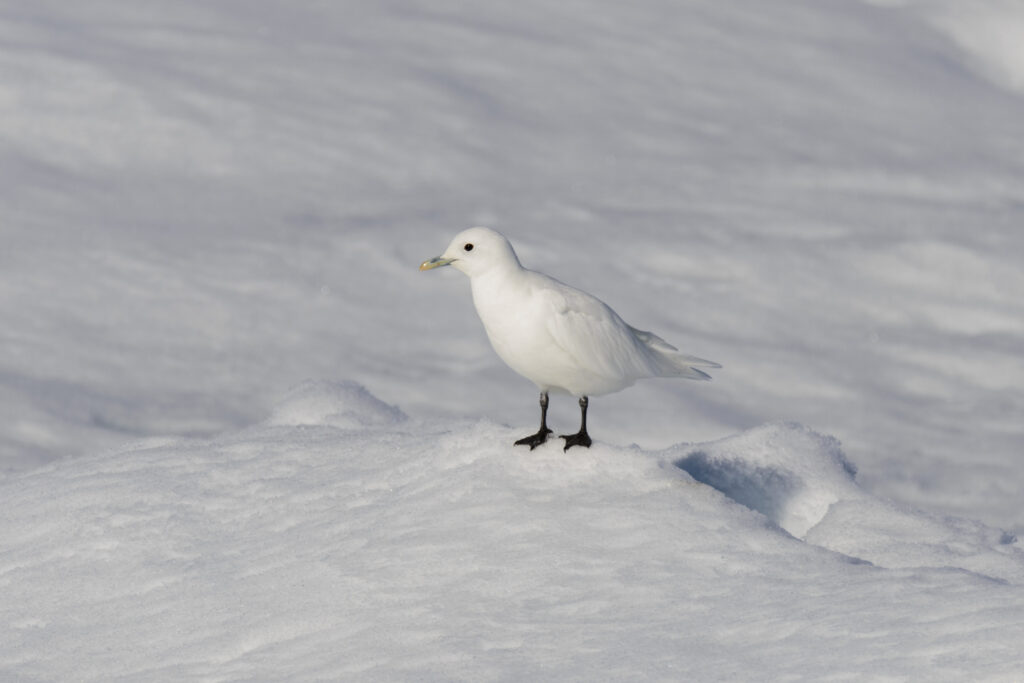
The Ivory Gull, a striking pure white bird found in the High Arctic, is facing severe challenges due to climate change. These gulls are highly dependent on sea ice for both hunting and nesting, making them particularly vulnerable to the rapid changes occurring in the Arctic. A study published in PLoS One revealed that Ivory Gull populations have declined by an alarming 80-90% in some areas over the past few decades. The research, conducted by Spencer et al., used satellite tracking to monitor Ivory Gull movements and found that these birds are almost never observed more than 5 kilometers from sea ice. As Arctic sea ice continues to diminish, Ivory Gulls are losing crucial habitat for foraging and breeding.
The impact of climate change on Ivory Gulls extends beyond habitat loss. These birds feed on small fish and invertebrates found near the ice edge, as well as scavenging from polar bear kills on the ice. The loss of sea ice is not only reducing their food sources but also exposing them to higher levels of contaminants. A study reported by the Global Education Project found that Ivory Gull eggs show higher concentrations of mercury and pesticides than any other Arctic seabird. This is likely due to their reliance on seal blubber left by polar bears, which accumulates high levels of pollutants. As sea ice declines, Ivory Gulls may be forced to alter their traditional migration routes and feeding patterns, with uncertain consequences for their survival. The combination of habitat loss, changes in food availability, and increased exposure to contaminants makes the Ivory Gull one of the Arctic species most at risk from climate change.
9. Hooded Seal: The Balloon-Nosed Diver
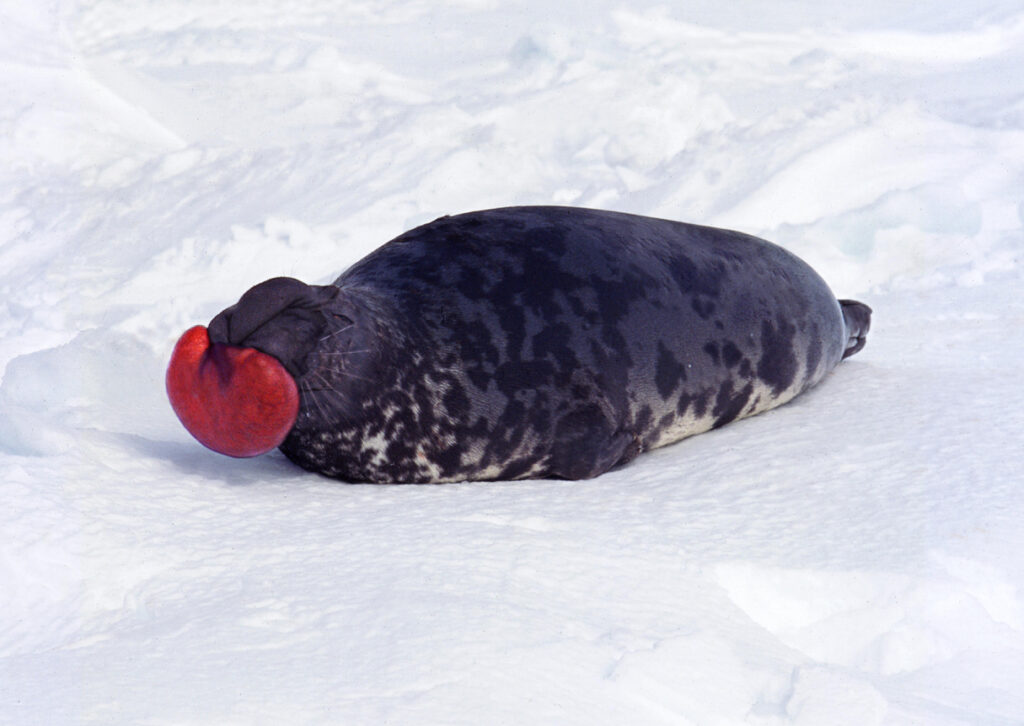
Hooded seals, known for the males’ inflatable nasal cavities used in mating displays, are facing significant challenges due to climate change. These ice-dependent seals rely on stable sea ice for breeding, pupping, and molting. A recent study published in NAMMCO Scientific Publications revealed a large decline in hooded seal pup production in the Northwest Atlantic. The research found that pup production at the Front (off northeastern Newfoundland) in 2012 and 2017 was only 38% and 36%, respectively, of the production estimated in 2005. This dramatic decrease mirrors a similar decline observed in the Greenland Sea population between 1997 and 2005/07, suggesting a widespread impact of climate change on hooded seal populations across their range.
The challenges facing hooded seals are multifaceted. Their pups have an incredibly short nursing period of just 3-5 days, making them particularly vulnerable to changes in ice conditions. As sea ice becomes less stable and breaks up earlier, many pups are separated from their mothers before they’re ready, leading to increased mortality. Additionally, changes in ocean temperatures and currents are affecting the distribution and abundance of the seals’ prey species, potentially leading to nutritional stress. The study also noted that extensive reconnaissance failed to locate significant whelping areas outside the traditional regions, indicating that the population decline is not simply due to redistribution. While the exact cause of the decline is not fully understood, the researchers suggest that negative impacts of ecosystem change on female fecundity and juvenile survival, similar to those documented for harp seals in the Northwest Atlantic, may be affecting hooded seals as well.
10. Harp Seal: The White-Coated Pup

Harp seals, famous for their fluffy white pups, are facing increasing challenges in a rapidly changing Arctic environment. These seals rely heavily on stable sea ice for breeding and nursing their young. However, climate change is altering the extent and quality of their ice habitat, particularly in their southern range. A study published in the ICES Journal of Marine Science examined the impact of changing climate and abundance on harp seal reproduction in the Northwest Atlantic. The research found that environmental factors, particularly ice conditions, play a crucial role in the reproductive success of harp seals. In years with poor ice conditions, pup mortality rates can be extremely high, with some breeding areas experiencing up to 100% mortality.
The challenges for harp seals extend beyond the immediate threat to pups. The study also investigated the relationship between large-scale climate patterns, such as the North Atlantic Oscillation (NAO), and harp seal reproductive rates. While a direct correlation between NAO and pregnancy or abortion rates was not found, the researchers noted that the relationship between climate indices and environmental variables likely changed during the study period due to geographic shifts in climate patterns. This highlights the complex and dynamic nature of the threats facing harp seals. Additionally, the research emphasized that harp seals likely respond to environmental changes on a finer scale than captured by large-scale climate indices. As Arctic sea ice continues to decline and become less predictable, harp seals may face increasing difficulties in finding suitable breeding habitats and adapting their reproductive strategies to the changing environment.
11. Muskox: The Ice Age Survivor
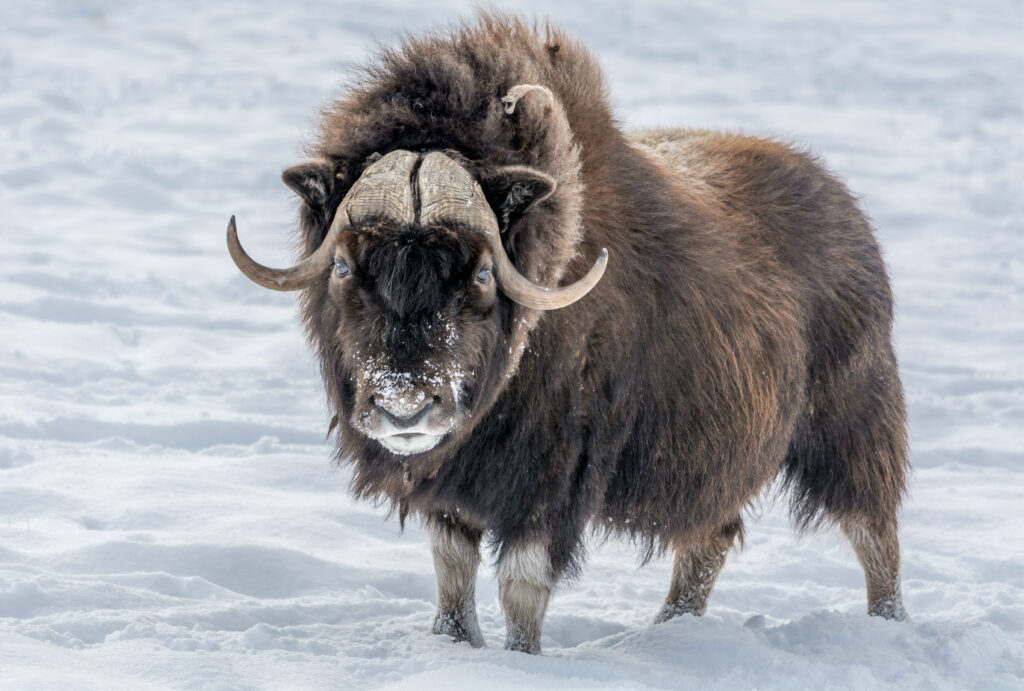
The muskox, a shaggy ice age relic, is facing new challenges in the rapidly warming Arctic. These hardy animals, adapted to extreme cold, are now contending with climate-induced changes that are altering their habitat and food sources. The Arctic Report Card, published by NOAA in 2024, highlights the dramatic shifts occurring in the Arctic tundra, which is the primary habitat for muskoxen. The report notes that the tundra is transitioning from a carbon sink to a carbon source due to increased wildfires and thawing permafrost. This fundamental change in the ecosystem is likely to have far-reaching effects on muskox populations, altering the vegetation they rely on for food and potentially exposing them to new parasites and diseases.
One of the most immediate threats to muskoxen is the increasing frequency of rain-on-snow events, a direct result of warming temperatures in the Arctic. These events create a layer of ice over the tundra vegetation, making it difficult or impossible for muskoxen to access their food. A study published in the journal Nature Climate Change found that such icing events can lead to mass starvation among muskox herds. The research documented a case where more than 20,000 muskoxen died on Banks Island in the Canadian Arctic due to a single extreme icing event. As climate change continues to alter precipitation patterns in the Arctic, these devastating events are likely
12. Lemming: The Boom-and-Bust Prey
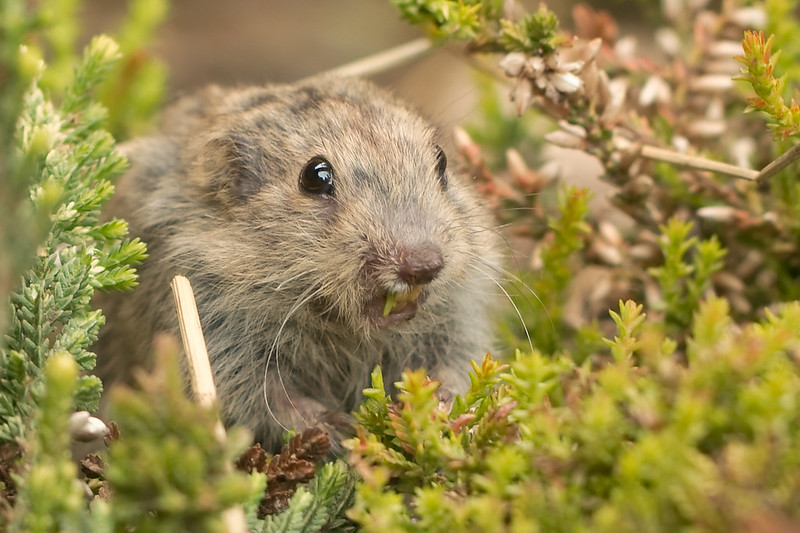
Lemmings, small rodents that play a crucial role in Arctic food webs, are facing significant challenges due to climate change. These creatures are known for their cyclical population booms and busts, which have a ripple effect throughout the Arctic ecosystem. However, research published in Nature Climate Change has shown that warming temperatures are disrupting these cycles, leading to more erratic and less predictable lemming populations. This disruption has far-reaching consequences for the entire Arctic food web, as many predators, including Arctic foxes, snowy owls, and various bird species, rely heavily on lemmings as a primary food source.
The impact of climate change on lemmings is multifaceted. More frequent winter heat waves and rainstorms are creating hard, icy snow that makes it difficult for lemmings to tunnel and access food. A study in the journal Biology Letters found that lemming populations in parts of Norway and Sweden have not experienced a single peak since the 1990s, coinciding with warmer, wetter winters in these regions. This change affects the lemmings’ ability to build nests and reproduce, potentially disrupting their typical population cycles. The researchers suggest that these alterations in lemming populations could have cascading effects throughout the Arctic ecosystem, affecting everything from vegetation patterns to predator populations.
13. Arctic Ground Squirrel: The Hibernation Expert

Arctic ground squirrels, known for their remarkable ability to lower their body temperature below freezing during hibernation, are facing new challenges in a warming Arctic. These small mammals play a significant role in Arctic ecosystems, serving as prey for many predators and influencing soil composition through their burrowing activities. However, a study published in Global Change Biology has found that climate change is altering the timing and duration of their hibernation periods. As spring arrives earlier and fall extends later, Arctic ground squirrels are spending less time in hibernation, which could have significant impacts on their energy balance and survival rates.
The changing climate is also affecting the Arctic ground squirrel’s habitat and food sources. Research conducted by the University of Alaska Fairbanks has shown that warmer temperatures are leading to increased shrub growth in tundra areas, which can reduce the visibility and mobility of these ground-dwelling animals. This change in vegetation could make them more vulnerable to predation and affect their foraging success. Additionally, the study found that climate-induced changes in plant phenology could lead to a mismatch between the squirrels’ emergence from hibernation and the availability of their preferred food sources. This mismatch could result in nutritional stress for the squirrels, particularly for females preparing for reproduction. As key members of the Arctic ecosystem, the fate of Arctic ground squirrels could have far-reaching implications for the region’s biodiversity and ecological balance.
14. Snowy Owl: The Arctic Hunter
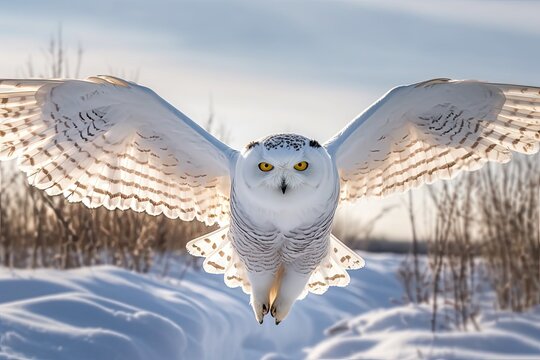
Snowy owls, iconic birds of the Arctic tundra, are facing increasing challenges due to climate change. These majestic predators rely heavily on lemmings and other small rodents for food, making them particularly vulnerable to changes in prey populations. A study published in Oecologia found that snowy owl breeding success is closely tied to lemming abundance, which is becoming more unpredictable due to climate change. The research showed that in years with low lemming populations, snowy owls may not breed at all, leading to concerns about long-term population stability.
Climate change is also affecting the snowy owl’s habitat and range. As the Arctic warms, the tree line is moving northward, reducing the open tundra habitat that these birds prefer for nesting and hunting. A report from the National Audubon Society predicts that climate change could result in a 56% loss of current snowy owl breeding range by 2080. Additionally, warming temperatures are altering the timing of snow melt and freeze-up, which can affect the camouflage effectiveness of the snowy owl’s white plumage. This change could make hunting more challenging for these birds and potentially increase their vulnerability to predators. The combination of these factors – changes in prey availability, habitat loss, and altered camouflage effectiveness – poses significant threats to snowy owl populations and highlights the complex ways in which climate change is impacting Arctic species.
15. Arctic Cod: The Icy Water Survivor
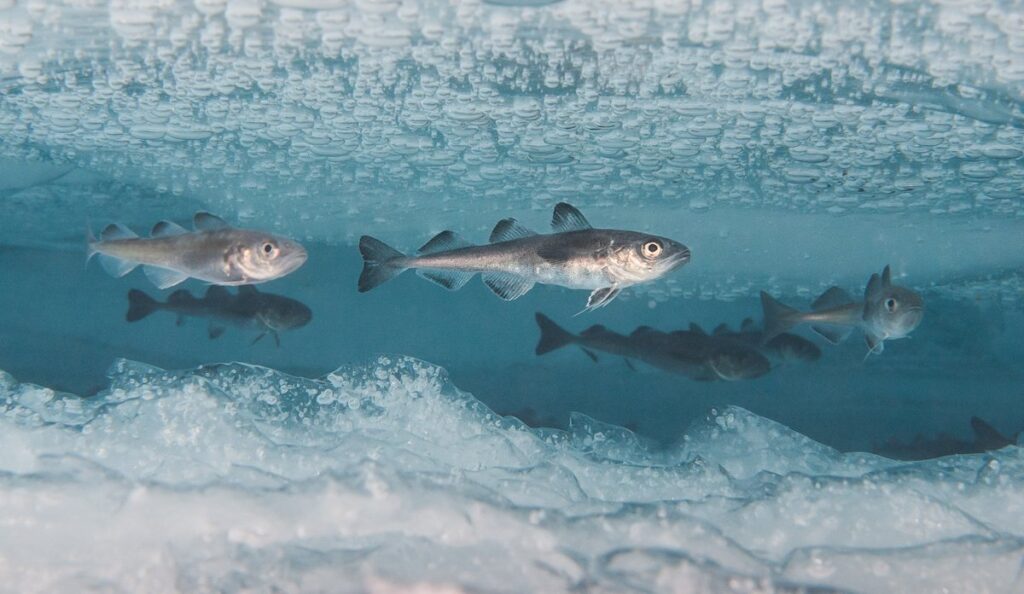
Arctic cod, a key species in the Arctic food web, is facing significant challenges due to climate change. These small fish are highly adapted to life in cold, ice-covered waters, with antifreeze proteins in their blood allowing them to survive in sub-zero temperatures. However, as Arctic waters warm, their habitat is shrinking. A study published in Science Advances found that the distribution of Arctic cod is closely tied to the extent of sea ice. As ice coverage decreases, these fish are being forced to move further north, potentially disrupting the entire Arctic marine ecosystem. The research predicts that by 2100, Arctic cod could lose up to 70% of their current habitat due to warming waters and reduced sea ice.
The decline of Arctic cod has far-reaching implications for the Arctic food web. These fish serve as a crucial link between plankton and larger predators like seals, whales, and seabirds. A report from the Arctic Monitoring and Assessment Programme (AMAP) highlights that the loss of Arctic cod could lead to a cascade of effects throughout the ecosystem. As Arctic cod populations decline or shift northward, their predators may face food shortages or be forced to switch to less nutritious prey. Additionally, the warming waters are allowing more temperate fish species to move into Arctic waters, potentially outcompeting Arctic cod for resources. This shift in species composition could fundamentally alter Arctic marine ecosystems, with unpredictable consequences for the region’s biodiversity and the communities that depend on these resources.
16. Arctic Char: The Colorful Cold-Water Survivor

Arctic char, a close relative of salmon and trout, is facing significant challenges due to climate change. These fish are known for their striking color variations, ranging from silver to bright red during spawning season. A study published in Nature Climate Change found that warming temperatures are causing rapid changes in Arctic freshwater ecosystems, directly impacting species like Arctic char. As water temperatures rise, these fish are being forced to move further north or to higher elevations in search of colder waters. The research predicts that by 2100, suitable habitat for Arctic char could decrease by up to 73% in some regions, potentially leading to local extinctions.
The changing climate is also affecting the char’s food sources and breeding grounds. Research conducted in Canada’s High Arctic has shown that warmer temperatures are altering the timing of insect hatches, a crucial food source for Arctic char. This mismatch in timing can lead to nutritional stress for the fish. Additionally, changes in river flow patterns due to melting glaciers and altered precipitation are impacting spawning habitats. A long-term study in Greenland revealed that some populations of Arctic char have declined by up to 30% in recent decades, largely attributed to climate-induced changes in their habitat. These findings highlight the urgent need for conservation efforts to protect this iconic Arctic species and the ecosystems it inhabits.
17. Greenland Shark: The Arctic’s Ancient Mariner
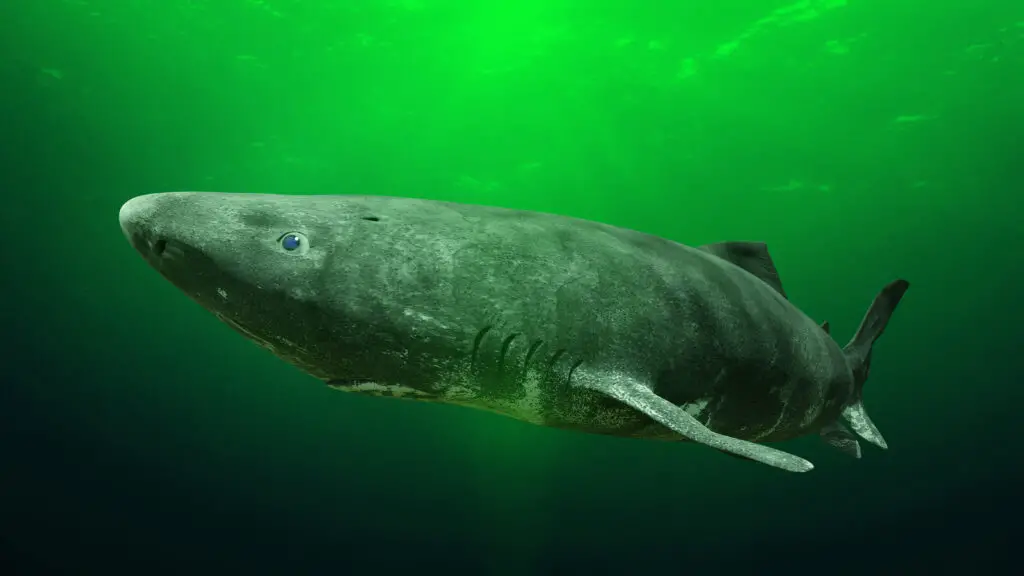
The Greenland shark, one of the longest-living vertebrates on Earth with a lifespan that can exceed 500 years, is facing new challenges in a rapidly changing Arctic. These slow-growing, deep-sea dwellers are particularly vulnerable to the effects of climate change and increased human activity in the Arctic. A study published in the journal Science reported that warming ocean temperatures could potentially disrupt the Greenland shark’s metabolic processes, which are adapted to very cold, stable environments. This disruption could affect their growth, reproduction, and overall survival. The research suggests that even small changes in temperature could have significant impacts on these long-lived creatures, potentially altering their distribution and behavior.
As Arctic sea ice retreats, previously inaccessible areas are opening up to commercial fishing, potentially increasing the risk of accidental catch (bycatch) of Greenland sharks. Research published in PLOS ONE has shown that bycatch is a significant threat to these sharks, with hundreds caught annually in some fisheries. The loss of sea ice is also altering the distribution of the shark’s prey species, forcing them to adapt their feeding patterns. Scientists from the Greenland Institute of Natural Resources have noted changes in the shark’s distribution, with some individuals being found further north than ever before recorded, likely in search of their preferred cold-water habitat. These shifts in distribution could have cascading effects on Arctic marine ecosystems, as Greenland sharks play an important role as apex predators in these environments. The combination of direct threats from fishing and indirect impacts of climate change poses significant challenges for the conservation of this ancient and mysterious species.


